8 Fascinating Things You Probably Didn’t Know About Mummies
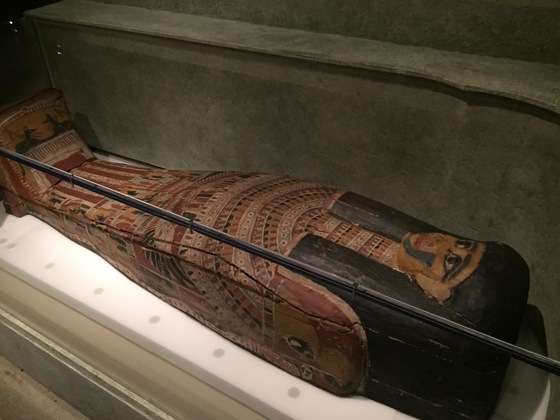 |
| Liz Ohanesian |
For Dr. Ryan Williams, curator of South American Archaeology at Chicago’s The Field Museum and an expert on Peruvian mummies, there’s one big misconception that people have about carefully preserved, ancient bodies. “I think we’ve created a perspective of the mummy as something scary,” he says. For the classic horror fan, it’s hard not to separate the reality of the mummy from images od Boris Karloff lumbering across the silver screen with an unraveled shroud and prune-y skin.
Like vampires and zombies, mummies love to pop-up as the weather cools and the candy corn becomes plentiful. But unlike their fellow not-quite-dead horror film icons, mummies aren’t fiction. You can go to a museum to see remains of human lives that date back thousands of years. That’s what I did on a recent weekday morning, when Los Angeles’ Natural History Museum prepared for the opening of “Mummies: New Secrets from the Tomb,” which runs from September 18 through mid-January of 2016. The exhibition features mummies from Egypt and Peru that are usually found at The Field in Chicago. While I was touring the exhibition and talking to Dr. Williams, one of the experts on hand for the launch of this event, it was obvious that real-life mummies are a lot more interesting than their fictional counterparts. Here are 8 fascinating things you probably didn’t know about them.
1. Ancient Egyptians Weren’t the First to Mummify Their Dead.
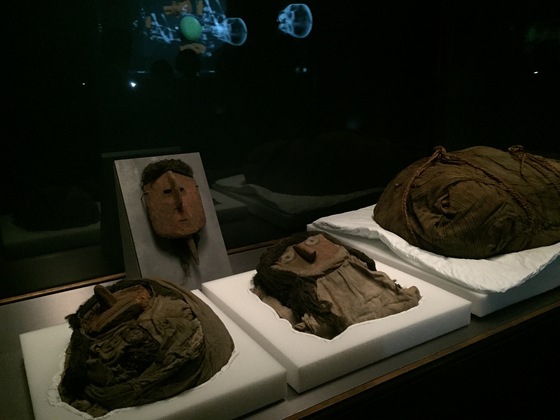 |
| Liz Ohanesian |
| Some ancient Peruvians made masks to accompany mummies. |
If you watch a movie or read a story about a mummy, chances are good that there will be a connection to Egypt in it. While ancient Egyptian mummies are the best known preserved corpses, they aren’t the oldest. About 7000 years ago, long before the Egyptians were doing their thing, in what is now southern Peru and northern Chile, a people known as the Chinchorro were mummifying bodies. Not only that, but various groups who existed in that region continued to mummify the dead for millennia. So, why is it that these South American discoveries remain relatively obscure?
One reason, Dr. Williams says, is that archaeologists have been studying Egypt longer than the Americas. But, that leads to another major point. “Egyptian mummies have been well known, I think, because it’s been part of our Western cultural heritage,” he says. Think about it like this: If you spent your childhood in the U.S., classes on ancient history probably don’t go beyond Egypt, Greece and Rome. As for our pop culture, that’s often derived from the Egyptian/Greek/Roman traditions too. However, as Williams points out, there are other parts of the world filled with “as deep and glorious pasts as Egypt and Western civilizations.” Peru is one of those places.
2. There Are Mummies Across the Globe, but They Need Specific Climates to Survive.
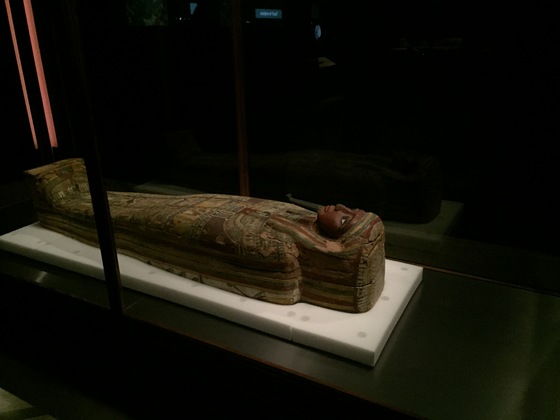 |
| Liz Ohanesian |
Williams points out that mummies can be found in all sorts of places, from Europe to China to Papua New Guinea. However, to keep the bodies at least kind of intact, they need a very specific climate to survive. He points out that even though the Chinchorro lived close enough to the Pacific ocean to survive off of fishing, their home base is a desert. Dryness is good for mummies, but it can’t be too dry – “the skin will crack,” he says – and the temperatures need to stay fairly even. Also, there shouldn’t be too much oxygen. If there is, he explains, bacteria might wreck the soft tissue. In museums, the staff can control all of these factors to keep the mummies from deteriorating. In nature, that’s a lot more difficult, which is why mummies are often found in tombs or caves.
That said, it’s unlikely that you’ll stumble upon a random mummy while you’re investigating an old house or something like that. According to Williams, it’s pretty rare that bodies preserve this way naturally.
3. Mummies Can Provide Valuable Knowledge About Health.
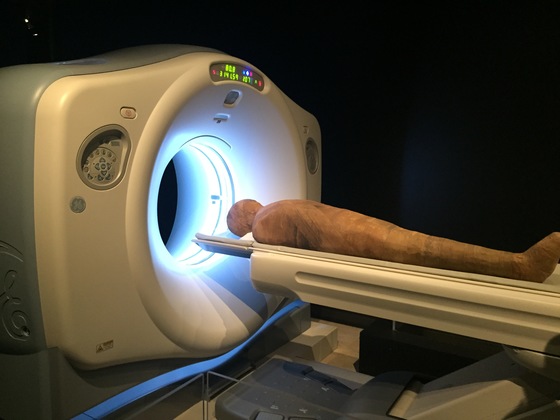 |
| Liz Ohanesian |
Today, technology has made studying mummies a lot easier. Thanks to CT scans, researchers can study these bodies without disturbing them. Through their examinations, they can gain new insight into human health. They can look at the effects of diseases like tuberculosis and see how the lifestyles of ancient peoples shaped their health. They can also see how mobile ancient people were, by looking at DNA to see if they’re related to others found in the same area.
By studying mummies, researchers can also get a look into certain hereditary health issues, but this is a field that’s still growing. Williams explains that the study of ancient DNA is pretty new and the technology is still developing. Once this advances, though, researchers might be able to learn some amazing things about hereditary diseases.
In pop culture, mummies are essentially the nerd-magnets of horror, always attracting people with an interest in studying the distant past. Real life isn’t all that different, except that the people who dedicate their work to these finds might just discover new ways that we can approach disease.
4. It’s Possible to Get a Good Idea of How Mummies Once Looked.
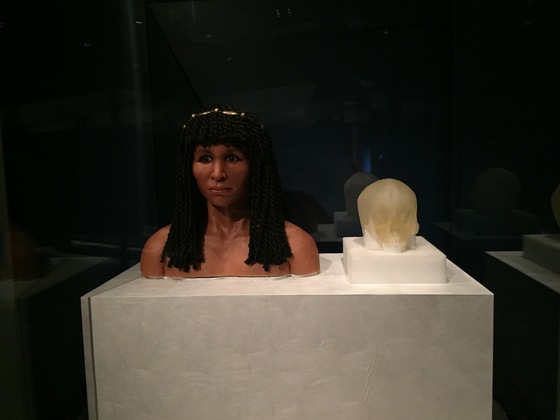 |
| Liz Ohanesian |
If you watch Bones, you probably already know about forensic anthropology and how people can do a pretty good job of reconstructing a face with limited information. That’s part of what’s going on in the mummy world as well. At this exhibition, a French artist created two recreation of faces based on mummies in the Egyptian portion of the exhibition. “We can probably get fairly accurate to the facial structure and how the soft tissue may have been applied,” says Williams. The rest of the person’s appearance is open to interpretation. “Things like skin color, eye color, those are things that we have to invent or guess at based on genetic knowledge from surrounding populations and things like that.”
Information on hair color is sometimes available, as some mummies do still have hair. The hair is also something that researchers can study to learn about things like toxins and beauty procedures. However, this isn’t something that researchers look at too often. “It is an invasive procedure to go in and take the hair out,” says Williams, “so we would want to have a fairly good research question before we would do something like that.”
5. Mummies Don’t Travel Easily.
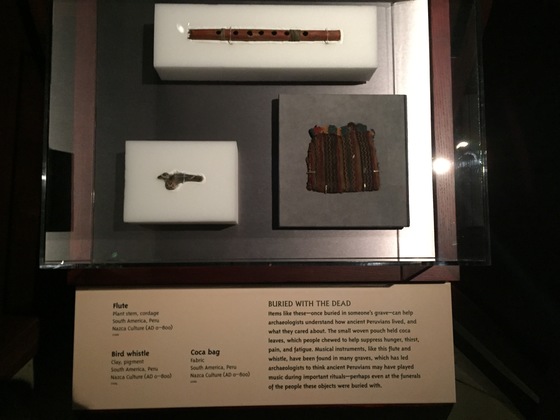 |
| Liz Ohanesian |
| Mummies don’t pack lightly and they aren’t easy to pack either. |
Going back to the 1932 film The Mummy; do you recall how Imhotep just wanders out of his sarcophagus? Obviously, that’s not going to happen in real life, but it’s also not likely that people will just take them out of the coffin and walk them around either. Mummies don’t travel well.
In fact, bringing a small group of mummies from Chicago to Los Angeles is quite an ordeal. “We selected only the mummies that we thought were stable enough to travel,” says Williams. In addition, the mummies couldn’t travel by plane, as they can be adversely affected by changes in air pressure. They have to be packed up carefully into boxes that are made to fit the objects exactly. Plus, they need mummy chaperones who can make sure that humidity levels and temperatures remain ideal during the haul.
6. Mummification Wasn’t Just for the Rich.
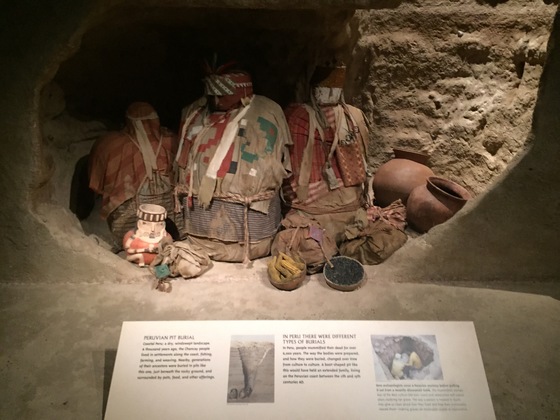 |
| Liz Ohanesian |
Because the emphasis is often on ancient Egyptian mummies, many of us likely associate this post-mortem process with Pharaohs and other high-society types. In South America, though, mummification wasn’t reserved for the rich. Williams says that the Chinchorro tradition of mummies is both unusual and fascinating. The process of preserving the body is intense; It involved taking off the skin and sewing it back on the body, as well as making clay masks for the deceased. What’s unusual, he says, is that it appears that they didn’t have specific people doing this job and this likely wasn’t a luxury.
7. Mummies Reveal Mourning Traditions That Aren’t All That Different From Ours.
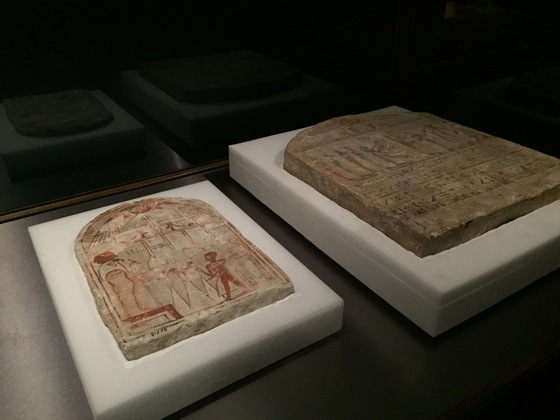 |
| Liz Ohanesian |
| Tombstone-like pieces from ancient Egypt |
Ancient Egyptians often buried their dead with a variety of items that helped prepared them from the afterlife. In this exhibition, there are small statues and even a nice piece of jewelry, none of which seems all that strange when you think about how morticians prepare the dead now. At a funeral, the deceased might be wearing a nice suit or dress and presented in an ornate casket. Moreover, for years later, loved ones might leave mementos – at the very least, flowers – on the grave.
In Peru, the traditions were vastly different and did morph over time. Williams explains that archaeologists believe that families kept the mummy in the home with them for quite some time before finally burying it. I ask if that was like a wake. “It may have been a very prolonged wake,” he answers. He adds that the evidence also points to instances where loved ones may have visited tombs and brought the mummies out to join the living for feats. Is it that different from a trip to a cemetery? “I think one of the important things in the Peruvian context, though, is actually seeing the mummy as part of that,” he says, “where, for us, it’s going to visit the tombstone or the ground in which the person is buried.”
Think that’s strange? Try driving down Santa Monica Blvd. in Los Angeles when throngs of people are angling to get into a movie screening in a graveyard. That’s pretty weird. I’ve actually attended one of those screenings at Hollywood Forever Cemetery and still think it’s weird.
Plus, there’s a huge difference between modern and ancient peoples when it comes to mourning. We have photos, video and all sorts of reminders of our long-gone loved ones. Perhaps if we didn’t, a picnic with a mummy wouldn’t seem like such an odd idea.
8. Respect for the Dead Is Important, Even When They’ve Been Gone for Thousands of Years.
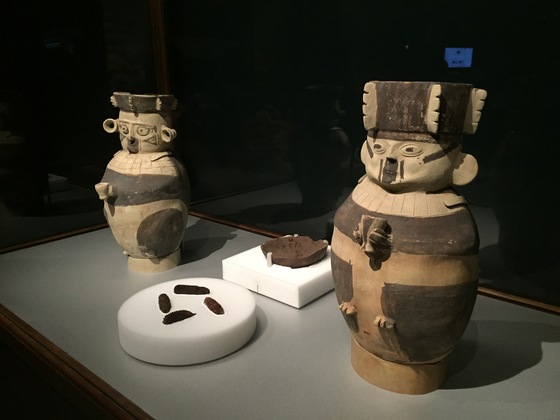 |
| Liz Ohanesian |
At the “Mummies” exhibition, there are displays that visitors are not allowed to photograph. Oftentimes, that’s because they contain exposed skeletal remains and it’s more a sign of respect than anything else. When it comes to mummies, the phrase “too soon” applies, even though the bodies here expired thousands of years ago.
“There are different ways to respect the dead too,” says Williams, adding that some people might think that simply checking out mummies is a faux pas. “You have to look at the cultural traditions of the people from where the mummies came from,” he explains. “You have to respect cultural values that both modern and past peoples had with regard to mummies.”
For example, he says, his team is careful about where they will investigate for mummies. “If societies are actively working on practicing and understanding their past through the study of mummies and if they are exhibiting mummies as they do in Peru,” he adds, “then we’re just following their lead in what are the culturally appropriate standards for working with human remains for understanding people’s ancestors.”
That’s probably the biggest difference between the mummies of fact and the mummies of fiction. These aren’t monster movie foes who need to be defeated. “What this exhibit actually shows is that the reason they are preserved is because the people who loved them cared for them so well in order to preserve their bodies for a very long period of time,” Williams says. “I think that’s something that we should celebrate and think about. These are the memories of individuals and through the care their relatives gave them, they are, in some way still around today.”
Previously by Liz Ohanesian
Getting an Up Close Look of 8 New Virtual Reality Experiences
“7 Things We Want to See in a Xena: Warrior Princess Reboot”
“7 Awesome Things We Saw and Heard at the Saturn Awards”
“9 Lessons Learned at Adult Swim’s Potentially Touring Drive-In Event”
“10 Creepy Awesome Things We Saw at ‘Son of Monsterpalooza'”
“8 Things We Learned at L.A.’s Anime-Centric EigaFest”
“8 Things I Learned at Power Morphicon 2014”
“The 18 Coolest Exclusives to Snag at San Diego Comic-Con 2014”
“20 Best Cosplays We Saw at Anime Expo 2014”
“14 Episodes of Highlander You Need to Watch”
“7 Lessons Learned From Watching Star Wars with Someone Who Never Saw It”
“9 Awesome Things You Might Not Know About Cartoon Network Studios”
“7 Reasons Why Marvel Superhero Movies Are Really Boring”
